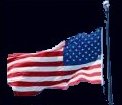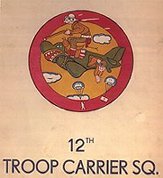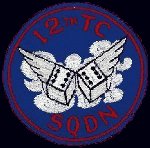





The 12th Transport Squadron, which was later to become the 12th Troop Carrier Squadron, was born on December 1st, 1940, and was at best a very puny infant. 1st Lt. Arthur L. Logan was appointed commander of the squadron, but all that appointment entailed was the title, for the squadron had no men, equipment, or airplanes.The squadron remained an organization in name only until February 1st, 1941.
When World War II began to escalate, the 12th Troop Carrier Squadron, now flying Douglas C-47 aircraft, was sent to England, and along with  other Troop Carrier Wings, participated in Operation Torch, the invasion of North Africa. Many troop drops were made and of course the squadron did yeoman duty in air logistics to supply and transport the invading Americans along with air ambulance duty flying wounded troops to medical facilities.
other Troop Carrier Wings, participated in Operation Torch, the invasion of North Africa. Many troop drops were made and of course the squadron did yeoman duty in air logistics to supply and transport the invading Americans along with air ambulance duty flying wounded troops to medical facilities.
When Africa was secure, the 12th was in on the invasion of Sicily, again dropping troops in the initial invasion and then continued the supply and medical evacuation work. When Sicily was secure, the 12th followed the Army up the boot of Italy, and did extensive supply and evacuation work in the Balkan countries, finishing the war in southern Germany.
supply and medical evacuation work. When Sicily was secure, the 12th followed the Army up the boot of Italy, and did extensive supply and evacuation work in the Balkan countries, finishing the war in southern Germany.
At the end of the war, the 12th was inactivated, and did not emerge again as an operation squadron until the beginning of the Berlin Airlift in 1948. The 12th, along with its two sister squadrons, the 10th and 11th Troop Carrier Squadrons, were now flying Douglas C-54 aircraft as part of the 60th Troop Carrier Wing. The 12th was briefly based at Wiesbaden, Germany before
 joining the 10th and 11th at Rhine-Main Air Base, Frankfurt. Every available aircraft from around the world was called into service for that humanitarian effort. The 314th Troop Carrier Wing was called to Germany from the Far East, and that group contained elements of another 12th – the 12th Combat Cargo Squadron of China-Burma-India fame, and the two 12th Squadrons were combined within the 60th at Rhine-Main. The three squadrons of the 60th were equipped with the first Fairchild C-82 Packet aircraft in the last months of the Airlift.
The Wing and its squadrons were not deactivated when the Airlift was over, but continued to serve as the first-line Combat Cargo unit in the European theater, North Africa and the Middle East.
joining the 10th and 11th at Rhine-Main Air Base, Frankfurt. Every available aircraft from around the world was called into service for that humanitarian effort. The 314th Troop Carrier Wing was called to Germany from the Far East, and that group contained elements of another 12th – the 12th Combat Cargo Squadron of China-Burma-India fame, and the two 12th Squadrons were combined within the 60th at Rhine-Main. The three squadrons of the 60th were equipped with the first Fairchild C-82 Packet aircraft in the last months of the Airlift.
The Wing and its squadrons were not deactivated when the Airlift was over, but continued to serve as the first-line Combat Cargo unit in the European theater, North Africa and the Middle East.

In 1951, the C-82s of the 12th were retired, and were replaced with the new Fairchild C-119C Packet, unofficially known as “Flying Boxcar,” and continued to fly that model until the summer of 1955. At that time, the 12th was moved, lock, stock and barrel, to Dreux/Senonches Air Base, France, along with other two squadrons of the 60th. At that time, they were equipped with the new Fairchild C-119G aircraft—the last and newest ones built and also the last military aircraft to be equipped from the factory with a Morse key, and the last to carry a full time radio operator. The 12th continued their tradition of airlift excellence until 1962 when Dreux Air Base was closed and the aircraft returned to storage in the United States. At that time, the 12th was once again inactivated until the Vietnam conflict when it re-emerged as the 12th Airlift Flight, a unit designed to ferry VIPs and do courier work for the Air Force, flying Lear C-21 aircraft, and now based as part of the 1st Fighter Wing at Langley AFB, Virginia.
| Last Flight of The 12th Squadron |
Sadly, the 12th has once again been inactivated, and its aircraft dispersed around the country, but there is no doubt when Airlift Excellence is needed in the future, the 12th will be reactivated and will continue to deliver in the image of the rich tradition for which the 12th Troop Carrier Squadron, the 12th Combat Cargo Squadron and the 12th Airlift Flight are famous.





